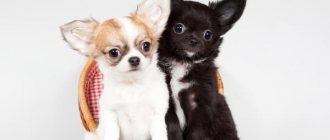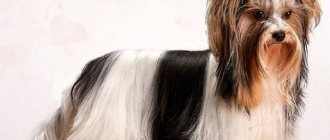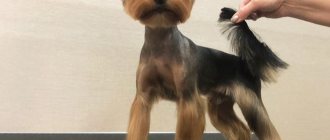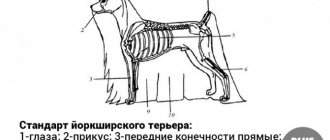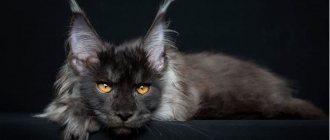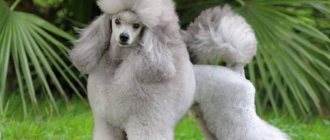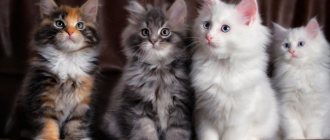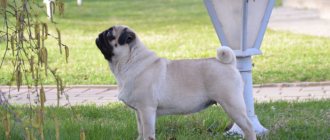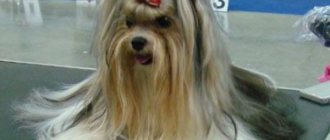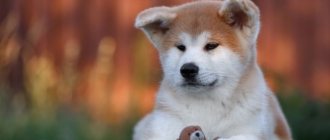Yorkie's coat is the dignity of this breed, its pride. And color is an important characteristic. The breed standard clearly regulates the color of the Yorkie .
So, the colors should be as follows:
- blue - dark steel blue, but not silver blue and should not be mixed with fawn, bronze or black hair;
- Tawny - Tan hair is darker at the base, gradually lightening towards the end. Should not be mixed with black hair.
Dogs are often born one color depending on the breed and begin to change colors with age. Likewise, Yorkshire Terrier puppies are born with smooth black hair with red markings. Red spots should be on the muzzle, under the tail, on the outside of the hind legs, on the inside of the front legs from the armpits, extending slightly onto the chest.
With the correct coloring of the puppy, the main part of the body should be bronze underneath, with the exception of a black spot on the sternum. The lower part of the jaw and throat are also bronze. Red spots can be of different shades, from golden yellow to dark golden bronze. These spots may be larger or smaller, may be distinct, or may be mixed with black hairs.
Some puppies may have small white spots or stripes on their chests, which indicate that there will be melanism or excess pigment. It is also possible that puppies will have white marks on one or more toes. It’s okay if the white color “goes away” with age.
It is important that a newborn Yorkie's nose is often gray or pink, but by 21 days it should turn black.
It is important to know that if Yorkie puppies are of a certain color, they should be deprived of the right to belong to the breed. This happens if the puppy was born completely black, bronze, bronze with black spots or gray. These puppies may change color slightly as they grow older, but will most likely remain that way for life. Such puppies are the result of incorrectly inherited genes. You've probably heard of the so-called "Rare Blue" or "Rare Golden" Yorkshire puppies. They simply don't exist. I repeat that the breed standard contains clear requirements for the color of the Yorkshire Terrier's coat. But such puppies are only suitable for home keeping and documents for them, if issued, must necessarily contain the mark “breeding marriage”.
How do Yorkie puppies grow?
At about 40 days of age, puppies already have all their baby teeth. By 3 months, the terrier's ears take on a standing position. By about 4 months the chest is formed, by 5 months the body grows in length, and from 7 months in height, mainly due to the limbs. ... Intensive growth from 2 to 4 months, at 8 months the Yorkie is already formed.
Interesting materials:
How does catfish taste? What was the name of the fairy Tinker Bell? What were the names of the fox and the hare from Zootopia? What was the name of the Sultan in the Magnificent Age? What were the names of the participants in the Crusades? What were the names of all the heroes in Dubrovsky? How to make calls using Skype for Business? How to call Altel secretly? Which blouse goes with a blue skirt? What paper is suitable for photography?
Main stages of development
3 weeks . At this age, newborn Yorkies begin to open their eyes. Only now will they see the world around them for the first time! In cases where necessary, the Yorkie's tail should have been docked shortly after birth and will most likely have already completely healed.
4 weeks . The Yorkie puppy has learned to walk, although he may sometimes stumble. The puppy becomes very active and enjoys exploring his new world. At this time, a gradual transition from liquid to solid food should begin.
8 weeks . At this age, the Yorkie can be given to his new home. At this time, the puppy is ready for light training and socialization. At this point, the puppy should be on solid food and should be weaned from its mother.
From 3 to 6 months . During this period, your Yorkie's ears will begin to straighten. As you can see, the age at which a Yorkie's ears go up varies greatly, so there is generally no cause for concern if your dog goes through this stage a little later than others.
From 4 to 7 months . At any point during this period, Yorkies will begin teething.
From 5 to 9 months . At this time, female Yorkie girls usually go into heat for the first time. It is highly recommended that the female be spayed unless you are planning to breed. This will significantly reduce her chance of developing ovarian and breast cancer.
1 year . This is the age when your puppy is considered an adult dog. Puppy food can now be replaced with food for adult dogs.
8 years and older . Although Yorkies often live up to 16 or even 20 years, from the age of 8 they can be considered senior dogs. Therefore, it is time for change again, when you should change their food, increase the frequency of visits to the veterinarian, and also change their daily routine.
Unrecognized colors
It is worth noting that not all dogs fit the described breed standard. There are a considerable number of terriers that have rather unusual colors. Unrecognized colors that do not fit the standard include the following six types of coat colors.
Biro York
These dogs are very similar in appearance to Biewer Yorkies.
Their main feature is that they do not have the gene that is responsible for the appearance of black fur. That is why such Yorkies are only light in color. Additional Information! This variety of Yorkies appeared relatively recently and therefore they do not have a standard.
Beaver York
The Biewer Yorkie is a rare breed of Yorkie.
They are quite rare. Biewers look unusual; their appearance is in many ways similar to Biro-Yorks. They are also painted in light colors. However, some dogs have darker fur. Most often it occurs on the head. The body is painted white, sometimes with a silver tint.
Golddust
Such dogs are considered the rarest, since they are not found as often as others. The main distinguishing feature of these dogs is their unusual golden coat color.
Until 2007, they could not be classified into any breed. However, in the middle of this year they were officially identified as a separate breed called “Golddust”. The homeland of these dogs is Germany, but today they can be found in other countries.
Mermaid
These are quite beautiful and unusual dogs that can be called mermaids. This variety was bred relatively recently in Russia. These dogs differ from other animals in their long and thick hair. It is painted golden, with a slight yellowish tint.
Chocolate
The Chocolate Yorkie is one of the most beautiful representatives of the breed.
Sometimes dog breeders decide to get themselves chocolate terriers.
They, like the silver Yorkie, have a fairly thick coat. At an early age, such dogs have softer hair. However, over time they become rougher. The coat is dyed dark. On the head it is completely black, on the body it is slightly lighter. Important! Chocolate York Terriers have a uniform coat, without multi-colored spots.
Black
Dogs with jet-black fur are considered quite rare. Therefore, most black terriers have a grayish or brownish coating on the surface of the body. Even if the dog was perfectly black at an early age, over time its shade may change slightly and become lighter.
Video - Yorkie development from 12 weeks to 1 year
The Yorkshire Terrier is a long-haired breed with no undercoat. This means that they hardly shed. Their fur is similar to human hair in that it has no undercoat, is constantly growing and rarely falls out (only when combed or damaged). Due to the structure of their coat, Yorkies are considered a hypoallergenic breed that does not cause allergies in people at all or extremely rarely.
According to the standard, the correct coat texture should be completely straight (not wavy), shiny, fine silky structure, not fluffy. The color of a Yorkie is a very important feature of the breed. The hair on the head is long, flowing and of a rich golden red-brown color; at the same time, the color is more intense on the sides of the head, at the base of the ears and on the muzzle, where the hair is longest. The golden-brown color of the head should not extend to the neck and should not have any admixture of gray or black hair. The color is a dark steel-blue (not silver-blue) extending from the occipital protuberance to the base of the tail.
Mixtures of tan, bronze or dark hair are not allowed. The fur on the chest is an intense bright golden brown color. All golden brown hair is darker at the roots than in the middle and becomes even lighter towards the ends. The limbs are well covered with hair of a golden red-brown color. In this case, the ends of the hair are shaded lighter than the roots. Golden brown should not extend above the elbows and knees. The ears are a very rich golden brown color. The tail is abundantly covered with blue hair, a darker shade than on the body, especially at the end of the tail.
The coat color of many Yorkies does not correspond to the accepted standard. The golden-brown coat color can range from very light to dark brown, and the coat on the main body can range from black to steel or silver-gray. Experts note the relationship between coat structure and color. Dogs that are too dark rarely have a properly silky coat; it is usually wavy and, as they say, “puffy.” Light-colored dogs have a more regular texture, but their coat may yellow over time. It is believed that the most difficult task is to obtain a rich dark steel color, but it is with this color that dogs have a coat structure that best matches the standard and makes the best impression. Nowadays, many breeders attach much more importance to the quality of the coat compared to the color, in this way they manage to breed dogs with a uniform color and the correct structure of the coat.
DESCRIPTION OF INCORRECT TYPES OF WOOL:
Puppies bloom at a very early age. Sometimes they become light by 6 months. In this case, by 12 months they acquire a steel-whitish color with a silver tint, which is very undesirable for breeders.
Cotton wool . This coat is easily identified. Imagine combed cotton wool. In this case, the coat is usually dark and not shiny enough, almost faded, and at the same time it has a fine structure. The untrained eye will perceive such a coat as dark blue, although in fact it is the color of slate. This coat is incorrect and should be avoided.
Coarse wool . This coat is not so easy to identify in a puppy, but by 6 months it becomes sparse and uneven, as if damaged. This texture is easy to recognize as an adult, if only because it never grows to the desired length. It is hard to the touch. The color of this coat usually remains black. This coat is incorrect and should be avoided.
Black dull wool . It is no coincidence that we describe this wool last. Ask any breeder what he thinks of black dull wool and he will clutch his head in horror. This is the worst coat a Yorkie can have. Such wool should be strictly avoided. Such wool is always very thick and grows quickly, which misleads many breeders and experts. It is soft to the touch, like sheep's wool, and appears somewhat wavy at the ends. The puppies look like they are wearing a frilly dress. Such wool has absolutely no shine. As a rule, dogs with such hair have practically no neck, but at the same time they have a cute expression and make a pleasant impression. How many times have we seen judges who fall for the charm of this type, especially when the dog is showing well.
A show dog should not have any brownish or yellowish tints on its body. The definition of the word "tan" used in breed standards has often been misunderstood and introduced some uncertainty. The color should be similar to the 22 carat gold wedding ring. The gold color should be darker at the root, transitioning to lighter at the ends. There is also a type of wool that grows very slowly, the color is very dark blue, golden tan with a red tint, and the structure is somewhat wiry. This coat may become silky, but will never grow long enough to achieve high marks in the show. The golden color does not shimmer enough, and the hairs break easily.
Usual timing of shedding
It is believed that there are two “standard” age shedding patterns for the average dog:
- Puppies shed their first coat when they are about two months old. By this time, puppy fluff gives way to teenage fur. In its structure, the latter is already close to the adult coat. Note that in almost 90% of cases this can be seen with the naked eye, since juvenile fur is significantly different in color from “baby” fluff.
- Complete replacement with adult hair begins around the age of six months. Starting from this period, the cover becomes more and more rough and “seasoned”.
But! You should not assume that a six-month-old puppy will immediately develop adult hair. As a rule, this takes several lines. This is especially pronounced in representatives of long-haired breeds with an undercoat of complex “design”.
It takes a long time for the adult coat to change for Newfoundlands, Afghan hounds, and St. Bernards. But short-haired pets “change clothes” much faster: in most cases, at the age of one, they already have a full-fledged adult coat.
What causes coat change in general?
This process is called “age molting” and is completely natural. It is not difficult to understand that coat change begins at a certain age. In addition, there are several age groups, i.e. The pet's fur will change gradually and in stages.
Why does nature provide for a change of coat? It's simple. Initially, puppies require thick and soft fur, which protects them from temperature changes and allows them to retain body heat, provided that initially the pet’s thermoregulation systems do not work.
With age, the thermoregulation system of a young animal “comes to life”, after which the dog is no longer in danger of freezing at room temperature. Accordingly, the wool becomes coarser, as it turns into a universal protective cover, playing the role of not only “insulation”, but also “clothing” that protects the skin. In addition, among the ancestors of dogs, fur was a means of camouflage.
Origin story
Before getting a puppy of this breed, you need to familiarize yourself with the history of their origin.
Black and brown mini Yorkies come from representatives of small terrier breeds, among which there were many individuals with black colors.
Many dog breeders believe that it is because of this that even today you can find terriers whose undercoat is perfectly black. Additional Information! In rare cases, black Yorkies may have several colored spots or tan marks on their fur.
Before the breed standard was recognized, the Black Yorkie was considered an excellent rat catcher. Many people got dogs specifically so that they could catch rodents. At the same time, no one paid attention to what color and type of coat they had. This continued until the 19th century, until these dogs were given an official name and recognized as a separate breed.
What is the color and color of Yorkshire Terrier dogs?
Yorkshire terrier
The color of Yorkshire terriers is distinguished by genetic homogeneity. Representatives of the breed are characterized by a black-backed coloration, caused by a combination of asaasa genes. According to the standard, Yorkshire Terriers should be a rich golden-red hue with a grayish-blue saddle.
However, in reality, the color of dogs of this breed differs in the degree of intensity and purity of color. Among the Yorkshire terriers there are red ones with a black coat, and red-red ones with a bluish-silver coat, and golden-red ones with a coal-black coat, and individuals with a heavily blackened muzzle.
Like other black-and-white breeds, Yorkies are born black and tan. As it matures, the saddlecloth becomes very pale and becomes silver-blue or bluish-gray. At the same time, the richness of the red tan marks remains virtually unchanged. Such lightening is not due to the genes responsible for color change, but to age-related adjustments in the structure of the animal’s coat.
As the hairs grow, they become thinner, and inside there is a decrease in the density of the coloring granules, causing the color to fade. First of all, this applies to the black pigment – eumelanin.
Coloring grains containing the red pigment pheomelanin are significantly smaller in size and continue to easily penetrate thinned hairs and provide sufficient color intensity. Therefore, the richness of the red color in Yorkies remains almost unchanged with age. Due to this, the correct color is formed.
Other colors
Yorkshire terriers with non-standard coat colors appeared as a result of crossing standard individuals with representatives of other breeds or due to a gene mutation.
- Biewer Yorkshire Terrier. The coat on the Biewer's head has a three-color color: white, black and golden, and on the body there can be only 2 colors: white and black.
- Biro is a Yorkie . Like Biewers, Biro-Yorks are tri-colored, but they are distinguished by the complete absence of black hair. The characteristic color of this variety is chocolate-white with a golden tint.
- Russian salon . Yorkies - mermaids have a color of various red shades: from light golden to dark red.
They definitely do not belong to the standard, but Yorkies with a total predominance of one shade of color - white or black - are popular.
Below are typical photos:
Beaver
Biro
Russian salon
Rare
The rarity and inaccessibility of Yorkies of some colors does not make them less popular, rather the opposite. These varieties include:
- Chocolate Yorkshire Terrier. These dogs have an intense and uniform color of various shades of chocolate: from milk to bitter and rich brown. What makes them unique is the brown pigmentation of their nose, claws and paw pads.
- Goldust - Yorkshire terriers with a coat in golden shades, as well as Blue Diamond Goldust - Yorkies with sky blue irises.
Unusual coat colors give Yorkies individuality, unusualness and distinguish them from other representatives of the breed. However, before purchasing such a pet, it is important to remember that these dogs are not suitable for participation in exhibitions and cannot be used for breeding . To participate in international exhibitions and obtain a pedigree, the color specified in the official breed standard is required.
Peculiarities of age-related shedding of wire-haired dogs
Representatives of short-haired breeds with coarse, coarse hair quite rightly deserve a special mention. This, in particular, includes all “burrowers”, i.e. dachshunds and schnauzers. These dogs' fur is so hard that it cannot fall out on its own. It must be removed mechanically (i.e. trimming).
Puppies of such breeds need to be accustomed to this procedure (not very pleasant for them) from an early age, so that there are no problems in the future (even the need for anesthesia).
Therefore, the owner is responsible for periodically “pinching” the dog, since otherwise new hair will not grow back. This process is regular and requires special knowledge and skills. Fortunately, dogs with coarse coats have a mature coat within a year at most, so constant trimming is not required.
What will happen if you don’t remove old fur artificially? In this case, the pet can remain “forever young”: the adult fur, while growing, will not be able to coarse sufficiently, while continuing to remain soft to the touch.
I would like to warn especially “frugal” owners who, not wanting to pay for trimming, cut their dogs with a clipper or scissors: in this case, the result is similar. For domestic dogs, this is nothing particularly scary, but such dogs cannot be used for their intended purpose (for hunting purposes), and you can forget about any exhibitions and certificates.
Wool texture
According to the standard, the texture of the coat should be silky, heavy, flowing and straight. It should not resemble cotton wool or be too abundant, like a brush. The wool should shine and have a metallic sheen.
There is also a type of coat that grows very slowly, has a dark blue hue with golden tan and a reddish tint, as well as a wiry structure. This coat can be silky, but it is not very long - the kind that gets high points in shows. At the same time, the golden color is less iridescent and the hairs break off easily.
